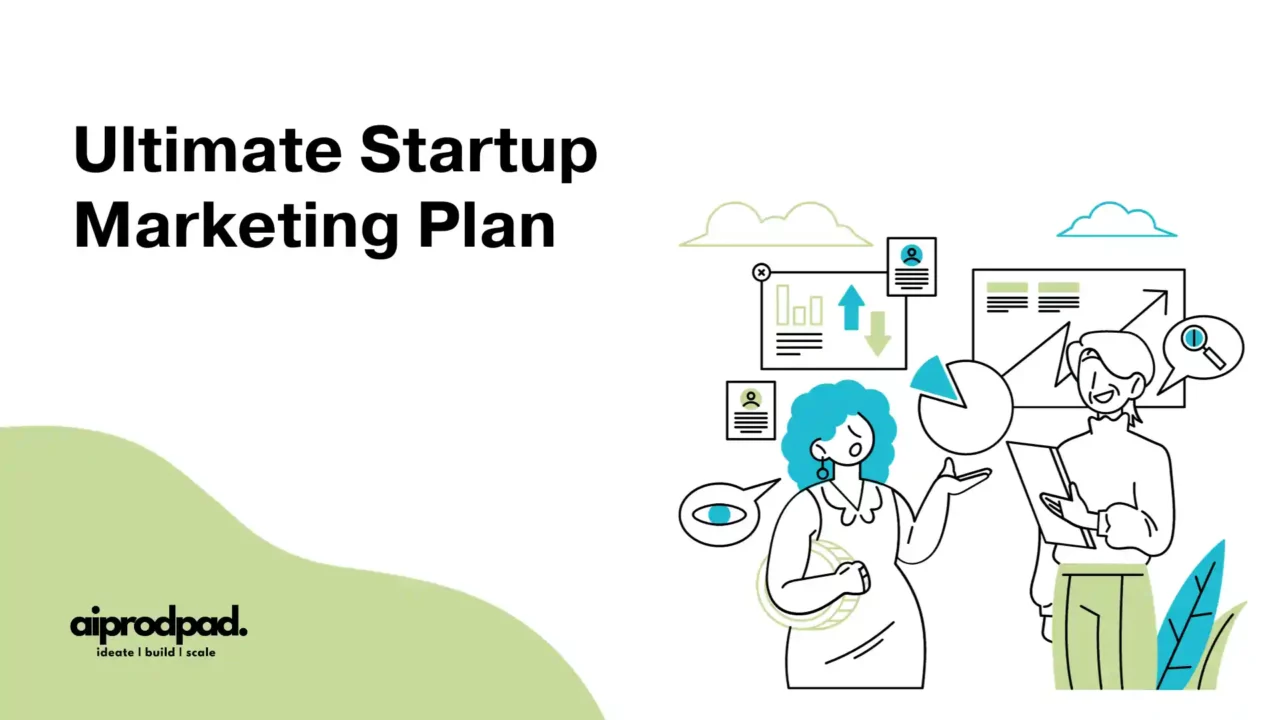Ultimate Startup Marketing Plan
Learn How to Create Your Ultimate Startup Marketing Plan
Introduction to the Ultimate Startup Marketing Plan
What is a startup marketing plan?
A startup marketing plan is a document that outlines how a startup will reach its target audience, promote its product or service, and achieve its business goals.
It should be a comprehensive and strategic plan covering all marketing aspects, from branding to content marketing to social media.
Why is a startup marketing blueprint important?
A startup marketing plan is important for several reasons.
First, it helps startups focus their marketing efforts and ensure they target the right people. Second, it helps startups to track their progress and measure the results of their marketing campaigns. Third, it helps startups attract investors and partners looking for businesses with a well-thought-out marketing strategy.
Benefits of Startup Marketing Blueprint
There are many benefits to having a startup marketing strategy, including:
- Increased brand awareness
- More leads and sales
- Improved customer loyalty
- Higher return on investment (ROI)
- More attractive to investors and other partners
How to create a startup marketing strategy

To create a startup marketing plan, you should follow these steps:
- Define your target audience. Who are you trying to reach with your product or service? What are their needs and wants? Where do they hang out online and offline?
- Set your marketing goals. What do you want to achieve with your marketing? Do you want to increase brand awareness, generate leads, or drive sales? Be specific and measurable in your goals.
- Choose your marketing channels. Where will you reach your target audience? Common marketing channels include social media, content marketing, email marketing, and paid advertising.
- Create a content marketing strategy. Content marketing creates and distributes valuable, relevant, consistent content to attract and retain a clearly defined audience and drive profitable customer action. What type of content will you create? How often will you publish new content? Where will you distribute your content?
- Promote your content. Once you have created your content, you must promote it so people can find it. You can promote your content on social media through email marketing and paid advertising.
- Measure your results. It’s important to track the results of your marketing efforts to see what’s working and what’s not. Common metrics to track include website traffic, social media engagement, leads generated, and sales.
Following these steps, you can create a startup marketing plan to help you achieve your business goals.
Additional tips for creating successful marketing for startups
- Be realistic about your budget and resources.
- Focus on a few key marketing channels rather than trying to do everything.
- Be consistent with your marketing efforts.
- Track your results and adjust your plan as needed.
- Don’t be afraid to experiment.
Creating a startup marketing plan may seem daunting at first, but it is an essential step for any startup that wants to be successful. Following the tips above, you can create a plan to help you reach your target audience, promote your product or service, and achieve your business goals.
Here are the steps for creating a startup marketing plan

Step 1: Define your target audience
- Who are you trying to reach?
- What are their needs and wants?
- Where do they hang out online and offline?
Define your target audience.
Defining your target audience is one of the most important steps in creating a successful marketing plan. Once you know your target, you can tailor your messaging and marketing campaigns accordingly.
Who are you trying to reach?
Start by thinking about the demographics of your target audience. This includes age, gender, location, income level, education level, and occupation. Consider their psychographics, such as their interests, values, and lifestyle.
You can narrow it down further once you have a general idea of your target audience. For example, if you are a clothing retailer, your target audience might be women aged 25-35 who are interested in fashion and have a moderate income.
What are their needs and wants?
Once you know your target audience, you must understand their needs and wants. What problems are they trying to solve? What are they looking for in a product or service like yours?
Market research lets you learn about your target audience’s needs and wants. This could involve surveys, interviews, or focus groups. You can also look at social media, online forums, and other online communities where your target audience is active.
Where do they hang out online and offline?
Once you know your target audience’s needs and wants, you must figure out where they hang out online and offline. This will help you to choose the right marketing channels to reach them.
For example, if your target audience is young adults, you should focus on marketing channels like social media and streaming services. If your target audience is older adults, you should focus on marketing channels like print and television advertising.
It is also important to consider where your target audience hangs out offline. For example, if you are a brick-and-mortar store, you should focus on marketing in your local community. If you are an online business, you should focus on marketing at industry events or trade shows.
By defining your target audience and understanding their needs, wants, and habits, you can create a marketing plan that is more likely to be successful.
Here are some additional tips for defining your target audience:
- Be specific. The more specific you can be about your target audience, the better. This will help you to create more targeted marketing campaigns.
- Consider their demographics and psychographics. Demographics include age, gender, location, income level, education level, and occupation. Psychographics include things like interests, values, and lifestyle.
- Do your research. Conduct market research to learn more about your target audience’s needs, wants, and habits.
- Be flexible. Your target audience may change over time, so be prepared to adjust your marketing plan accordingly.
Step 2: Set your marketing goals
- What do you want to achieve with your marketing?
- Do you want to increase brand awareness, generate leads, or drive sales?
- Be specific and measurable in your goals.
Set your marketing goals.
Once you have defined your target audience, you must set your marketing goals. What do you want to achieve with your marketing? Do you want to increase brand awareness, generate leads, or drive sales?
It is important to be specific and measurable in your goals. For example, instead of saying, “I want to increase brand awareness,” say, “I want to increase website traffic by 10% in the next quarter.”
Here are some examples of specific and measurable marketing goals:
- Increase website traffic by 10% in the next quarter.
- Generate 100 new leads per month.
- Increase sales by 15% in the next year.
- Increase social media engagement by 20% in the next six months.
- Improve customer satisfaction by 5% in the next year.
Once you have set your marketing goals, you must develop a plan to achieve them. This plan should include specific strategies and tactics that you will use to reach your target audience and achieve your goals.
Here are some tips for setting marketing goals:
- Be specific and measurable.
- Make sure your goals are aligned with your overall business goals.
- Set realistic and achievable goals.
- Break down your goals into smaller, more manageable steps.
- Track your progress and adjust your goals as needed.
By setting clear and measurable marketing goals, you can increase your chances of success.

Here are some additional tips for setting effective marketing goals:
- Make sure your goals are aligned with your business goals. What are you trying to achieve with your business? Your marketing goals should be aligned with your overall business goals.
- Set realistic and achievable goals. Keep your sights high. Start with small, achievable goals and gradually work up to bigger ones.
- Break down your goals into smaller, more manageable steps. This will make them seem less daunting and more achievable.
- Track your progress and adjust your goals as needed. Marketing is an ongoing process, so tracking your progress and adjusting your goals is important.
By following these tips, you can set effective marketing goals to help you achieve your business objectives.
Step 3: Choose your marketing channels
- Where will you reach your target audience?
- Common marketing channels include social media, content marketing, email marketing, and paid advertising.
As an educator, you have a unique opportunity to reach your target audience through various marketing channels. The best channels for you will depend on your specific goals and audience. However, some common marketing channels for educators include:
- Social media: Social media platforms like Twitter, Facebook, and Instagram are great ways to connect with students, parents, and other educators. You can use social media to share news and updates about your classroom or school, promote upcoming events, and engage with your audience.
- Content marketing: Content marketing involves creating and distributing valuable, relevant, consistent content to attract and retain a clearly defined audience and drive profitable customer action. You can use content marketing to create blog posts, articles, videos, and other helpful resources for your target audience.
- Email marketing: Email marketing is a great way to stay in touch with your audience and send them targeted messages. You can use email marketing to send newsletters, announcements, and other updates.
- Paid advertising: Paid advertising platforms like Google AdWords and Facebook Ads can help you reach a wider audience and promote your content or services. Paid advertising can be a great way to boost your visibility and drive traffic to your website.
In addition to these common marketing channels, educators can use several other channels to reach their target audience. For example, you can contact local media outlets for coverage for your school or classroom. You can also attend industry events and conferences to network with other educators and potential partners.
Here are some tips for choosing the right marketing channels for your educational institution:
- Consider your target audience. Where do they hang out online and offline? What marketing channels are they most likely to be exposed to?
- Consider your goals. What do you want to achieve with your marketing? Are you trying to increase brand awareness, generate leads, or drive enrollment?
- Consider your budget. Some marketing channels, such as paid advertising, can be expensive. Make sure to choose channels that fit your budget.
- Experiment. Feel free to experiment with different marketing channels to see what works best. You can always adjust your strategy as needed.
Following these tips, you can choose the right marketing channels to reach your target audience and achieve your educational goals.
Step 4: Create a content marketing strategy
- Content marketing creates and distributes valuable, relevant, consistent content to attract and retain a clearly defined audience and drive profitable customer action.
- What type of content will you create?
- How often will you publish new content?
- Where will you distribute your content?
Step 5: Promote your content
- Once you have created your content, you must promote it so people can find it.
- You can promote your content on social media, email marketing, and paid advertising.
Promote your content as an educator.
Once you have created your content, such as blog posts, articles, videos, and other helpful resources for your target audience, you must promote it so people can find it. Here are some tips:
- Social media: Share your content on social media platforms like Twitter, Facebook, and Instagram. You can also join relevant groups and communities to share your content with a wider audience.
- Email marketing: If you have an email list, send a newsletter or announcement promoting your new content.
- Paid advertising: You can use paid advertising platforms like Google AdWords and Facebook Ads to promote your content to a wider audience.
- Guest blogging: Guest blogging is a great way to reach a new audience and promote your content. Reach out to other educational websites and blogs in your niche and ask if you can contribute a guest post.
- Reach out to media outlets: If you have created newsworthy content, contact local media outlets and see if they are interested in covering it.
- Attend industry events and conferences: Attend industry events and conferences to network with other educators and potential partners. You can also use these events to promote your content and resources.
Here are some additional tips for promoting your content as an educator:
- Make sure your content is high-quality and informative. People are more likely to share and promote valuable and useful content.
- Use relevant keywords and hashtags. This will help people to find your content when they search for information online.
- Make it easy to share your content. Include social sharing buttons on your website and blog posts.
- Promote your content consistently. Don’t just promote your content once and then forget about it. Keep promoting it on social media, in your email newsletter, and at industry events.
These tips can promote your content more effectively and reach a wider audience.
Step 6: Measure your results
- It’s important to track the results of your marketing efforts to see what’s working and what’s not.
- Common metrics to track include website traffic, social media engagement, leads generated, and sales.
It is important to track the results of your marketing efforts to see what’s working and what’s not. This will help you improve your marketing strategy and ensure you reach your target audience.
There are many different metrics that you can track to measure the results of your marketing efforts. Some common metrics include:
- Website traffic: This is the number of visitors to your website. You can track website traffic using Google Analytics.
- Social media engagement includes likes, shares, and comments on your social media posts. You can track social media engagement using each social media platform’s analytics tools.
- Leads generated are the number of people who have expressed interest in your product or service. You can track leads generated using a CRM system or by tracking the number of people who sign up for your email list.
- Sales: This is the number of people who have purchased your product or service. You can track sales using an e-commerce platform or by tracking the number of people who register for your events or programs.
In addition to these common metrics, you can track other metrics specific to your educational institution. For example, you can track the number of students who enroll in your school or parents who attend your events.
Once you have tracked your results, you can use this information to improve your marketing strategy. For example, if you see that a particular marketing channel is generating many leads, you may want to invest more resources in that channel. Or, if you see that a particular type of content is not getting much engagement, you may create different types of content.
By tracking and measuring the results of your marketing efforts, you can ensure that your marketing is effective and that you are reaching your target audience.
Here are some additional tips for measuring the results of your marketing efforts:
- Set clear goals. What do you want to achieve with your marketing? Once you know your goals, you can choose the right metrics to track.
- Track your results regularly. Be sure to track your results before the end of the year. Track your results regularly so that you can identify any areas where your marketing needs to be improved.
- Use data to make decisions. Refrain from relying on gut instinct when making decisions about your marketing. Use your collected data to make informed decisions about your marketing strategy.
- Be patient. It takes time to see results from your marketing efforts. Keep going even if you don’t see results immediately. Keep at it, and you will eventually see the results you want.
By following these tips, you can measure the results of your marketing efforts effectively and use the data you collect to improve your marketing strategy.

Conclusion
Creating a successful startup marketing plan is essential for any startup that wants to be successful. By following the steps outlined in this article, you can create a plan that will help you reach your target audience, promote your product or service, and achieve your business goals.
Here are some additional tips for creating a successful startup marketing plan:
- Be specific and measurable in your goals.
- Focus on a few key marketing channels rather than trying to do everything.
- Be consistent with your marketing efforts.
- Track your results and adjust your plan as needed.
- Don’t be afraid to experiment.
Resources for creating a startup marketing plan
There are many resources available to help you create a startup marketing plan. Here are a few examples of startup marketing strategies:
- HubSpot Academy: HubSpot Academy offers several free online courses on marketing, including courses on startup marketing.
- SBA: The Small Business Administration (SBA) offers several resources for startups, including a guide on creating a marketing plan.
- SCORE: SCORE is a non-profit organization that offers free mentoring and advice to small businesses. SCORE mentors can help you to create a startup marketing plan.
Bonus section: Case studies of successful startup marketing plans
Here are a few case studies of real-world startups that have used successful marketing plans to achieve their business goals:
- Dropbox: Dropbox is a file-sharing service that has grown to over 700 million users. Dropbox’s marketing plan focused on word-of-mouth marketing and referral programs. Dropbox also offered a free tier of service to attract new users.
- Airbnb: Airbnb is a vacation rental platform that has grown to over 4 million listings in over 190 countries. Airbnb’s marketing plan focused on social media marketing and content marketing. Airbnb also partnered with local businesses to promote its listings.
- Slack: Slack is a communication and collaboration platform that has grown to over 12 million daily active users. Slack’s marketing plan focused on product-led growth. Slack offered a free service tier and made it easy for users to invite their colleagues to join the platform.
These are just a few examples of successful startup marketing plans. Consider your specific goals, target audience, and budget when creating your startup marketing plan.
This article has been helpful. If you have any questions about creating a startup marketing plan, let me know. We help marketing startups with branding, product marketing, and marketing communications.

